As Beijing intensifies its efforts to further isolate Taiwan diplomatically, Taipei is actively, but discreetly, broadening security ties with regional powers beyond its long-standing relationship with the US.
From efforts to share intelligence on China’s military with India to the prospect of engaging Japanese experts in its indigenous submarine program, Taipei’s push has gradually begun bearing fruit, despite sensitivities surrounding relations with Taiwan, according to government officials, military attaches and diplomats.
As well as India and Japan, Taipei has targeted Australia and Singapore.
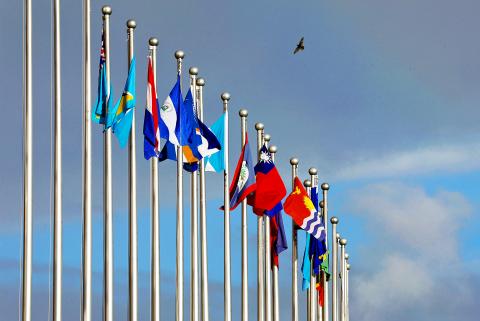
Photo: Tyrone Siu, Reuters
While the effort is being kept low-key to avoid further inflaming Beijing and adding to pressure on countries aiding Taipei unofficially, the moves mirror Taiwan’s more public New Southbound Policy to deepen commercial and cultural links with countries in South and Southeast Asia, as well as Australia and New Zealand.
It also comes amid several recent successes by China in luring away some of the few nations that diplomatically recognize Taiwan.
While Taipei battles to keep its remaining formal allies, it is keen to deepen strategic ties with larger regional powers, sensing an opportunity as they too seek to cope with a rising China, officials have said.
“We want Taiwan and those countries to have more in-depth understanding of the strategic or security environment we are in,” Minister of Foreign Affairs Joseph Wu (吳釗燮) said.
As China grows more powerful and assertive, “many of these countries feel the pinch and they might want to know more about Taiwan as an interest to them, rather than something they want to avoid,” he said.
El Salvador last month switched ties to Beijing, while the Dominican Republic did so in May and Panama changed sides last year — leaving Taiwan with 17 diplomatic allies, six of which are small Pacific island states.
“None of the other regional powers will come close to what Taiwan is doing with the US,” Washington-based Center for Strategic and International Studies security expert Bonnie Glaser said. “But it is clear that there are intersecting interests, and that these are being actively explored.”
Washington, like other major powers, maintains a “one China” policy that thwarts formal diplomatic relations with Taipei, but remains by far Taiwan’s largest weapons supplier and most powerful international backer.
That relationship has been boosted under US President Donald Trump, whose administration is eyeing more weapons sales and is encouraging official exchanges.
According to US estimates obtained by Reuters, an average of 100 US officials, including military personnel, visit Taiwan each week.
Anecdotally, the intensity of interactions is rising under the administration of President Tsai Ing-wen (蔡英文).
While security ties with Tokyo, including some intelligence sharing, have been evolving for some time, Taipei’s ties with New Delhi are rapidly growing, according to people familiar with discussions.
Unofficial military attaches have been placed within Taiwan’s new de facto embassy, the Taipei Economic and Cultural Center in India, while senior Indian military officers regularly visit Taipei on ordinary rather than official passports.
Taiwan also fields military attaches unofficially in Tokyo and Singapore, as well as Washington.
Taiwan’s knowledge of Chinese military deployments, including troop movements in the west of the country, are of particular interest, an Indian source said.
“We are dependent on Taiwan, because they are watching the Chinese,” the source said. “Indian [active-duty] officers regularly go to Taiwan, they go on so-called ‘study leave.’”
When asked for a formal Indian government response, a source familiar with the government’s thinking declined to comment on security cooperation, but said India’s “engagement with Taiwan is limited to economic and commercial links. And people-to-people contacts.”
Taiwan is also pushing Australia for closer cooperation, regional diplomats told reporters.
Discussions remained largely in the exploratory stage over shared interests over watching Chinese maneuvers in Southeast Asia and the Pacific, where China’s presence is growing.
Like the Indian relationship, it is most likely to evolve into information sharing on Chinese activities, deployments and intentions, rather than hard weapons’ programs.
An Australian government spokesman declined to comment.
Euan Graham, a regional security analyst at the Sydney-based Lowy Institute, said Australia would likely remain cautious, despite deepening understanding in Canberra of Taiwan’s strategic importance.
“It might be a bit ambitious of the Taiwanese to think Australia would go as far as say Japan,” Graham said. “Directly taking on a military-to-military relationship with Taiwan would be very uncomfortable for Australia.”
However, Singapore has repeatedly signaled to Taiwanese officials that it intends to maintain its low-key military presence in Taiwan, despite pressure from Beijing, people close to discussions said.
That decades-old presence — revolving detachments of troops for infantry and heavy armor training — faced Chinese criticism in late 2016, when Hong Kong authorities temporarily seized armored personnel carriers being shipped from Taiwan to Singapore.
“Taiwan is pleased that Singapore has resisted Chinese pressure and, beyond the training elements, exchanges between senior officers are broad and deep,” said one Singaporean academic familiar with the relationship, speaking privately due to sensitivity that surrounds it. “In the current environment, they have plenty to talk about.”
Speaking privately, other Singaporean academics have said that state-linked Chinese counterparts frequently complain about Singapore’s ongoing military relationship with Taiwan.
“They inevitably ask: ‘When is Singapore going to finally give this up?’ The hint is clear,” one senior academic said.
The Singaporean Ministry of Defence did not immediately respond to a request for comment.
Taiwanese academics said retired Japanese engineers have been visiting Taiwan to assist with research and development in its nascent submarine program.
The Ministry of National Defense referred reporters to an earlier statement by the navy, which said that reports of Japan’s assistance with Taiwan’s submarine program were “completely conjecture.”
A Japanese Ministry of Foreign Affairs spokesman said they had no knowledge of any involvement of Japanese engineers in the project.
“Our stance toward Taiwan is based on the 1972 joint communique by Japan and China, meaning our relationship is not an official one between governments, but is conducted at a working level,” the spokesman said.
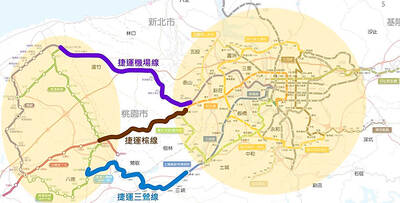
The Executive Yuan yesterday approved a southwestern extension of the Sanying MRT Line from New Taipei to Bade District (八德) in Taoyuan, with a goal of starting construction by late 2026. The 4.03-kilometer extension, featuring three new stations, will run from the current terminus at Yingtao Fude Station (LB12) in New Taipei City to Dannan Station (LB14), where it will connect with Taoyuan’s Green Line, New Taipei City Metro Corp said in a statement. This extension will follow the completion of core Sanying Line, a 14.29-kilometer medium-capacity system linking Tucheng (土城), Sansia (三峽)
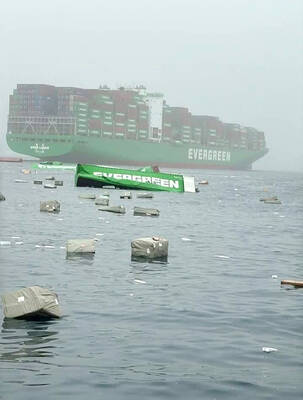
CARGO LOSS: About 50 containers at the stern of the ‘Ever Lunar’ cargo ship went overboard, prompting the temporary closure of the port and disrupting operations Evergreen Marine Corp, Taiwan’s largest container shipper, yesterday said that all crew members aboard the Ever Lunar (長月) were safe after dozens of containers fell overboard off the coast of Peru the previous day. The incident occurred at 9:40am on Friday as the Ever Lunar was anchored and waiting to enter the Port of Callao when it suddenly experienced severe rolling, Evergreen said in a statement. The rolling, which caused the containers to fall, might have been caused by factors including a tsunami triggered by an earthquake in Russia, poor winter sea conditions in South America or a sudden influx of waves,
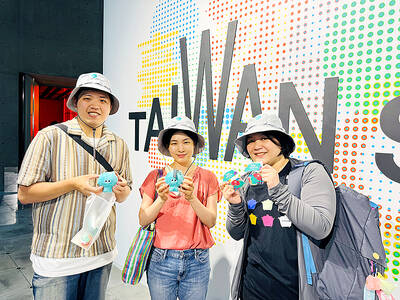
The Ministry of Culture yesterday officially launched the “We TAIWAN” cultural program on Osaka’s Nakanoshima sandbank, with the program’s mascot receiving overwhelming popularity. The cultural program, which runs from Aug. 2 to 20, was designed to partner with and capitalize on the 2025 World Expo that is being held in Osaka, Japan, from April 13 to Oct. 13, the ministry said. On the first day of the cultural program, its mascot, a green creature named “a-We,” proved to be extremely popular, as its merch was immediately in high demand. Long lines formed yesterday for the opening
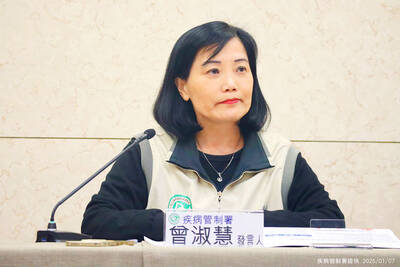
BE CAREFUL: The virus rarely causes severe illness or death, but newborns, older people and those with medical conditions are at risk of more severe illness As more than 7,000 cases of chikungunya fever have been reported in China’s Guangdong Province this year, including 2,892 new cases last week, the Centers for Disease Control (CDC) yesterday said it is monitoring the situation and considering raising the travel notice level, which might be announced today. The CDC issued a level 1 travel notice, or “watch,” for Guangdong Province on July 22, citing an outbreak in Foshan, a manufacturing hub in the south of the province, that was reported early last month. Between July 27 and Saturday, the province reported 2,892 new cases of chikungunya, reaching a total of 7,716